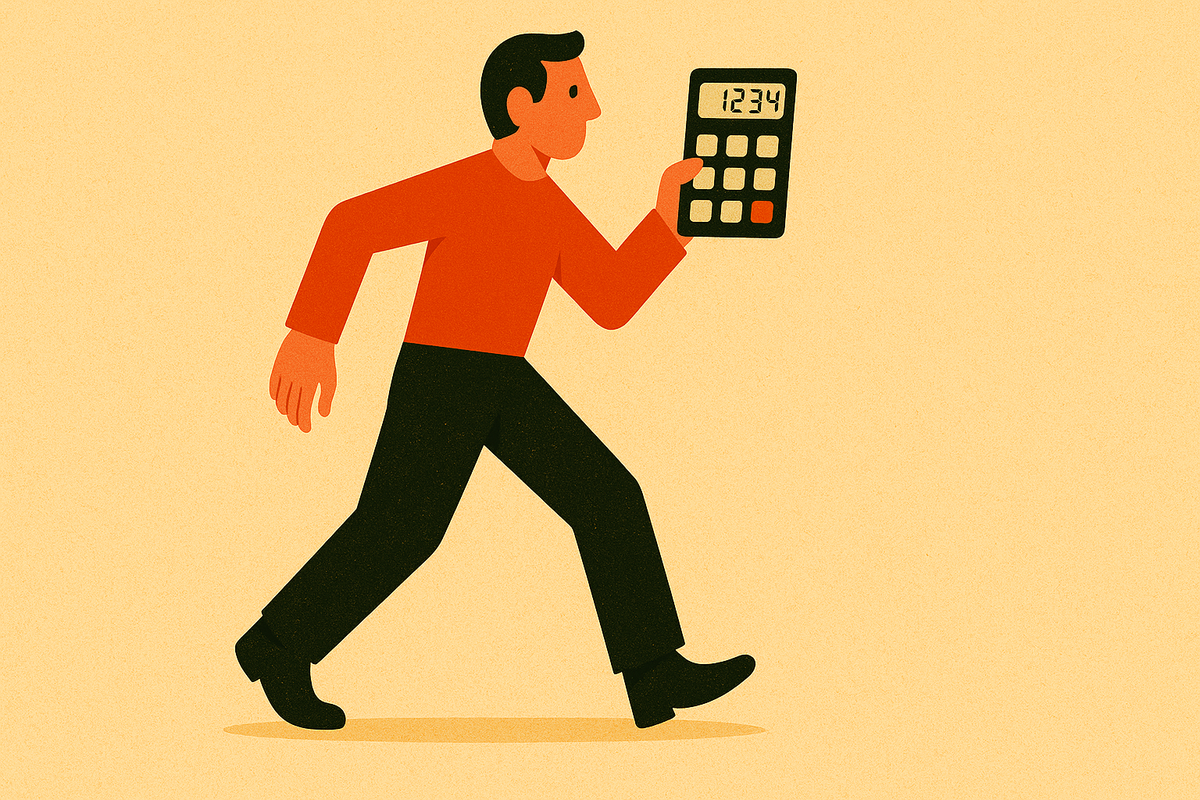Calculate how many steps per day to hit an annual step goal
Do you have a goal of hitting a certain number of steps per year? Calculate steps, miles, and hours per day, week, and month to hit an annual step goal.

In January 2023 I set out to reach 5,000,000 steps in a year. I had to take 13,699 steps per day to reach that goal — or so I thought. The truth was more complex, but you can read my story of hitting 5 million steps another day.
If you're interested in hitting an annualized step goal, you can use the calculator below to figure out how many steps you'll need to take every day, every week, and every month of the year (assuming it's not a leap year).
Once you calculate your steps, use the Google spreadsheet below to keep track. ⤵
Annual Step Goal Calculator
Track your daily steps
Now that you've run the numbers you need to hit to reach your goal, take the next, natural step: Track how many steps you've taken with this 🧮 Google spreadsheet ↗. Open the link, assuming you're logged into your own Google account, click "File → Make a copy." Then click to copy your calculated data from the step calculator and follow the instructions on the sheet.
Once you've got your own Step Spreadsheet, you can enter your daily steps and track your running step total. The spreadsheet will also tell you how many steps remain until you hit your annual goal. Finally, it will also calculate the daily steps (pace) you need to achieve your goal.
Looking for tips and strategies to get more steps in your day? Learn from the collective wisdom of walkers — specifically from the experts of Reddit in Your daily steps: Strategies for more movement, every day.
FAQ
How many steps in a mile?
A mile is 2,000 steps, assuming that the person is walking and of average height. This rule of thumb will change from person to person because the height of an individual — and their gait, or walking style — directly effects how far they travel per step.
For example, a taller individual will have longer legs and a longer stride, covering more distance per step than a shorter individual. Therefore, a taller individual could reach a mile in fewer steps — or will go more than a mile for every 2,000 steps taken.
How many steps per day does it take to lose weight?
Walking and increasing your steps (or running) will increase the work done by your body. Intuitively, most people expect that more steps per day will result in weight loss. So how many steps does it take to lose weight?
The answer is anything but clearcut. Here's how you can go about thinking about it. Let's break it down.
Begin by understanding how active (or inactive) you are every day. If you currently take 5,000 steps a day and your weight is stable, neither going up or down on a week to week basis, then this is your baseline.
If you go on to increase your daily steps to 20,000 steps per day, what might you expect to happen? This 15,000 extra steps would translate to 7.5 miles traveled (remembering that 2,000 steps is a mile walked). This amount of walking could easily take 2+ hours to complete. We'll come back to this in a minute.
So what would be the caloric impact of the extra 15K steps? A popular rule of thumb is that regardless of how you go the distance, for every mile traveled by foot, you will burn your weight in kilograms. If you weigh 100kg (220 lbs), that is 750 extra calories burned.
Take it a "step" further, given a pound of fat is 3,500 calories, it would take more than 9 hours of walking (and 33+ miles) to burn a pound of fat, again, assuming you weigh 220 lbs (100kg).
Not many people are going to walk more than a marathon distance in a day. So put another way, for an extra 2 hours of walking every day, you might expect to lose 0.21 pounds of fat — about 1.5 lbs/week. That's not bad!
What's the catch? Despite adding hours of extra activity to your day, you have to keep everything else about your daily habits the same — you can't eat more food and you still have to maintain your normal level of activity ("normal" meaning how it was before you started to move more!).
Combined with a steady or even improved diet, you are very likely to see weight loss by adding several thousand steps to your day and week. But as the saying goes, "abs are made in the kitchen." So be sure to think about your diet, including all the associated eating habits, if you want to lose weight by increasing your steps.
How many steps should I take in a day?
The truth is there is no clear answer to this question. The popular 10,000 steps per day originated as a marketing ploy. So the story goes, in 1965, a Japanese company launched a pedometer called the “10,000-step meter,” named not for science but because the character for 10,000 (万) looks like a walking figure. If you can't quite connect the dots between the Japanese character and the walking person, see this post (and also learn strategies for adding steps to your day).
Okay, so now you're back to square one. What to do? One approach is to benchmark your current steps per day for a week — what's your number per day on average? Use this number to benchmark your current activity level. Let's say it's 5,000 steps per day on average. Could you try 7,000? That would require an extra 15–20 minutes per day of walking to achieve. Try it and see how it feels!
Was adding 2,000 steps a day too easy? Try adding 5,000. Once again, see how that feels. Try it for several days or even a few months! What do you notice about your day-to-day habits?
Now, there is research into this, so what does it say? This research from the NIH found that, "compared with taking 4,000 steps per day, a number considered to be low for adults, taking 8,000 steps per day was associated with a 51% lower risk for all-cause mortality (or death from all causes). Taking 12,000 steps per day was associated with a 65% lower risk compared with taking 4,000 steps."
Your mileage may vary, but don't let the uncertainty stop you — challenge yourself based on your current lifestyle, and then just keep going!
Does running effect steps?
If walking a mile is around 2,000 steps, what is running a mile? Turns out that you take more steps per minute when you run, and you cover more ground when you run. The result is fewer steps taken running compared to walking.
A popular running cadence is 180spm (steps per minute). If you run a 10-minute mile at 180spm, you'll take 1800 steps in a mile! That's 200 fewer steps, oh my! Keeping that same running pace, but running an 8 minute mile, you'll only cover 8 minutes * 180spm = 1440 steps! Oh no!
If you're optimizing for steps alone, you might got a little nutty seeing how this math works out.
Here's the catch — and it totally favors running. If you run at 6mph (10-minute mile) for an hour, that's 6 miles. So 180spm * 60 minutes = 10,800 steps! Walking at a brisk pace of 15 minutes per mile would only get you to 8,000 steps. In other words, for the same amount of time, running will get you a good many more steps compared to walking — in this example 35% more steps in the same amount of time.
Why add more movement to your day?
What's the backstory on this calculator? How does adding a target daily step goal impact your life? "Your mileage will vary," but I found having an annual goal — one that required daily effort to achieve — had all kinds of positive benefits to my life, from improved heart rate to even learning I could run (having given up on it for 20 years!).
Read my nearly two-year journey to achieve 5 million steps over a one-year period:

New to BirthdayShoes?
BirthdayShoes was founded in 2009 and was the original site for the "barefoot shoes" enthusiasts. BirthdayShoes is fundamentally about getting stronger and healthier from the ground up — literally through helping your feet move more naturally. This can mean going barefoot or just using "less shoe." Or it could mean simply learning to walk with less impact.
If you like this kind of content, subscribe by email, and join the movement.


